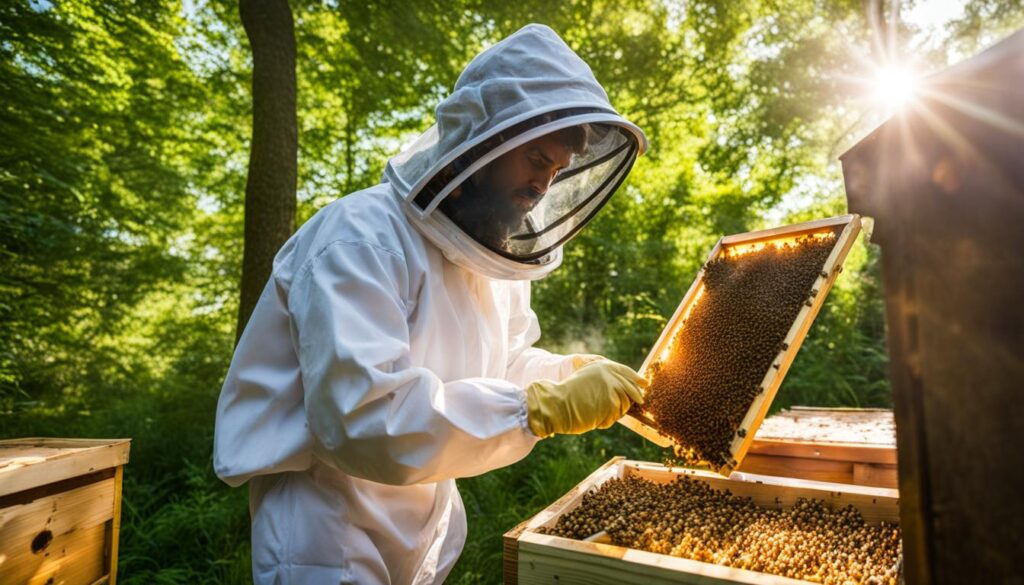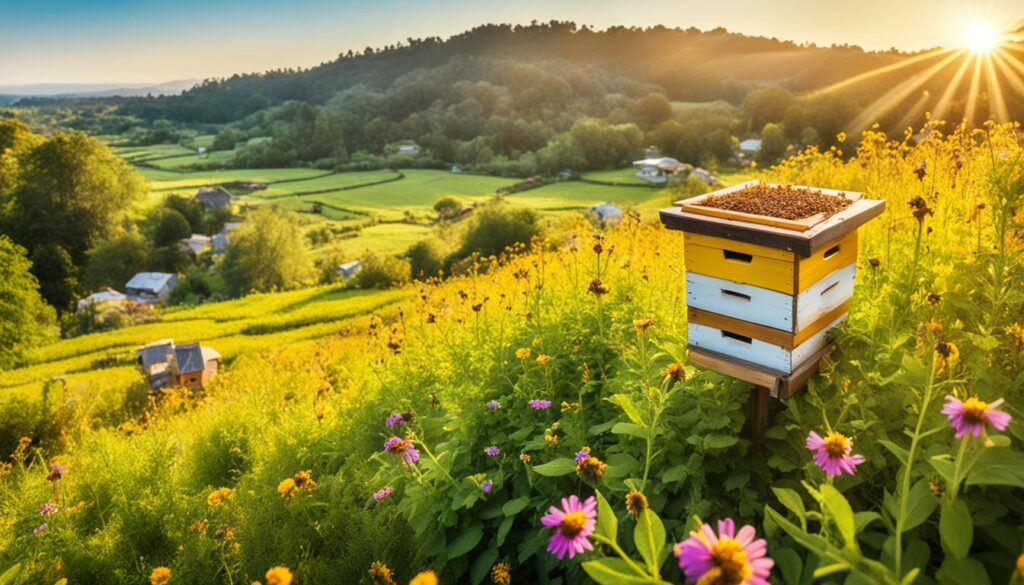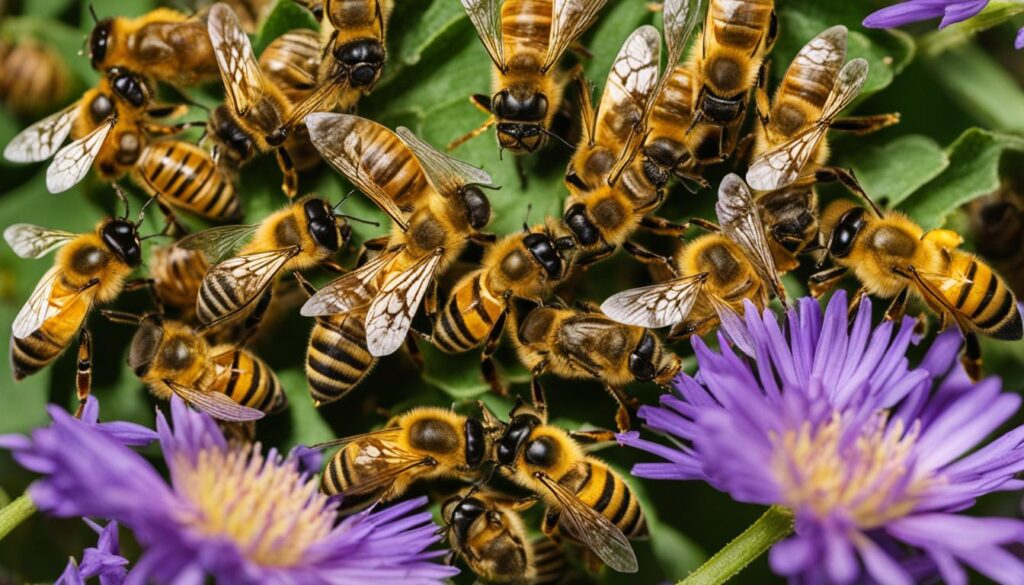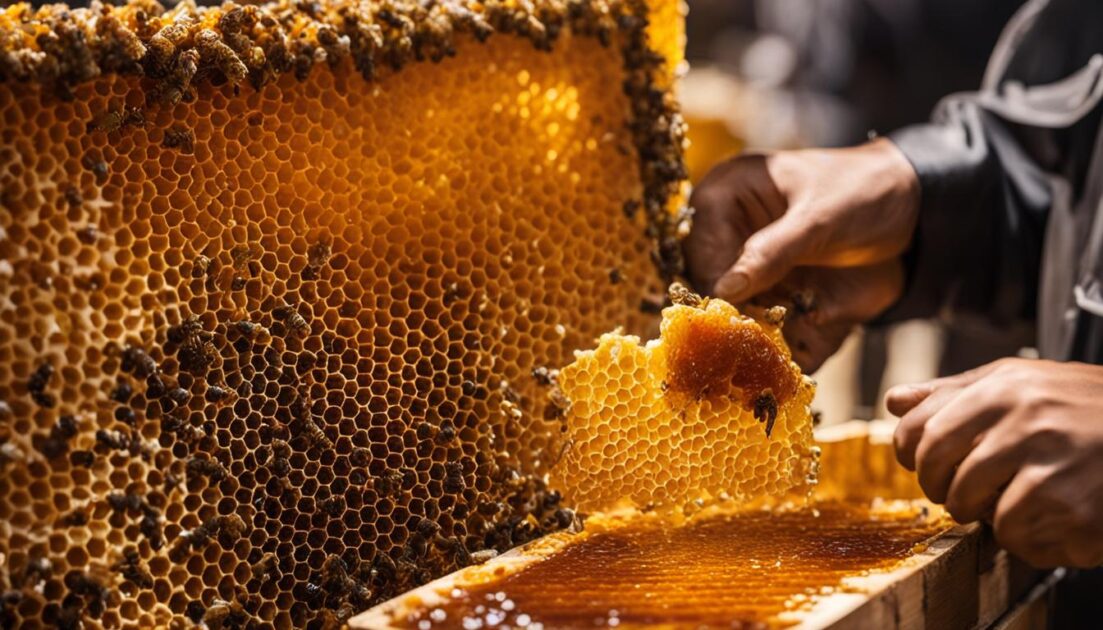Making honey at home is a fascinating process that requires understanding the intricate workings of a beehive. From collecting nectar to ripening the honey, bees go through several steps to create this sweet, golden substance. By following expert beekeeping tips, you can unlock the art of apiculture and make your own homemade honey right from your backyard.
Key Takeaways:
- Understanding the beekeeping process allows you to make honey at home.
- Beekeeping is a rewarding hobby that requires responsibility.
- The location of your hive impacts honey production.
- Essential equipment includes a Langstroth Hive and protective gear.
- Different breeds of honeybees offer unique characteristics for honey production.
The Art of Beekeeping: Becoming a Responsible Beekeeper
Beekeeping is a rewarding and fulfilling hobby that allows you to connect with nature and contribute to the well-being of honey bees. However, it also comes with a great responsibility. As a beekeeper, you play a vital role in ensuring the health and success of your colony. By following these beekeeping tips, you can become a responsible beekeeper and create a thriving environment for your bees.
1. Educate Yourself:
Before embarking on your beekeeping journey, it is important to acquire the necessary knowledge and skills. Joining a local beekeeping club or association can provide valuable resources and guidance. Attend workshops, seminars, and training sessions to learn about the fundamentals of beekeeping, hive management, and honey production. The more you know, the better equipped you will be to care for your bees effectively.
2. Provide a Safe Environment:
Creating a safe and secure environment for your bees is crucial. Protect your hive from potential predators such as bears, skunks, and mice by installing electric fences or using sturdy hive stands. Ensure there is ample ventilation to prevent moisture buildup and regulate the hive’s temperature. Regularly inspect your hive for signs of disease or pests, taking prompt action if necessary.
3. Monitor Food Supply:
Bees require a constant supply of nectar and pollen to thrive. Plant a diverse range of flowering plants in your vicinity to provide a consistent source of food throughout the year. During periods of nectar scarcity, consider supplementing their diet with sugar syrup or pollen substitutes. Regularly check their food stores and add additional honey frames if needed.
4. Harvest Honey Responsibly:
One of the joys of beekeeping is harvesting your own honey. However, it is important to do so responsibly while ensuring that your bees have enough honey to sustain themselves through the winter. Avoid overharvesting and only collect excess honey. Leave sufficient honey frames for the bees to survive during colder months when forage is scarce.
“I believe the key to successful beekeeping lies in understanding the needs and behavior of honey bees. By approaching beekeeping with empathy and respect, we can cultivate a harmonious relationship with these incredible creatures.” – John Smith, Experienced Beekeeper
5. Practice Sustainable Beekeeping:
Adopt sustainable beekeeping practices to minimize the impact on the environment and promote the well-being of honey bees. Use natural and organic methods to control pests and diseases whenever possible. Avoid the use of harmful chemicals, pesticides, and herbicides in and around your beekeeping area. By prioritizing sustainability, you contribute to the long-term health and viability of honey bee populations.
6. Maintain Regular Hive Inspections:
Regular hive inspections are essential to monitor the health of your colony. Check for signs of disease, pests, queen performance, and overall hive condition. Take notes and document your observations to track the progress of your hive over time. Early detection and intervention can prevent potential problems from escalating and ensure the well-being of your bees.

| Responsibilities of a Responsible Beekeeper |
|---|
| Provide a safe environment for bees |
| Monitor food supply and provide nourishment when needed |
| Harvest honey responsibly and leave enough for bees |
| Practice sustainable and chemical-free beekeeping |
| Maintain regular hive inspections and monitor bee health |
| Educate yourself and stay up to date with best beekeeping practices |
Choosing the Right Location for Your Hive
The location of your beehive plays a crucial role in honey production. Bees need access to abundant nectar and pollen sources to thrive and produce honey. If you live in an urban area with limited flora, the honey production of your hive may be compromised. However, if you have a rooftop or backyard with flowering plants, as well as propolis-producing trees nearby, you are well-suited for beekeeping. It is important to create an environment that supports bees’ foraging needs and provides them with a suitable habitat.
To ensure optimal honey production, here are some essential considerations for choosing the right location for your hive:
- Floral diversity: Aim for a location with a variety of blooming plants that can provide bees with a continuous supply of nectar and pollen throughout the year.
- Water sources: Bees need access to clean water for hydration and to dilute honey for feeding their larvae. Ensure that there are suitable water sources nearby, such as a pond, creek, or birdbath.
- Sun exposure: Bees thrive in sunny areas, so choose a location that receives adequate sunlight for at least part of the day. Avoid areas that are shaded for long periods as it can impact the bees’ foraging activities.
- Wind protection: While bees can tolerate some wind, excessively windy conditions can make it challenging for them to fly and forage. Consider placing your hive in a location that offers some wind protection, such as near a hedge or fence.
Example: Top 5 Plants for Honey Production
| Plant | Bloom Time | Nectar Yield |
|---|---|---|
| Tulip Poplar | Spring | High |
| White Clover | Summer | Medium |
| Goldenrod | Fall | High |
| Lavender | Summer | Medium |
| Sage | Summer | Low |
Remember, the more diverse and abundant the floral resources in your chosen location, the better your honey production will be. Bees are highly adaptable, but providing them with an ideal environment from the start can greatly enhance the success of your beekeeping venture.

Essential Equipment for Beekeeping
When it comes to beekeeping, having the right equipment is vital to the health and productivity of your hive. Here are some essential tools and gear that every beekeeper should have:
Hive Type
The most common type of hive used in beekeeping is the Langstroth Hive. It consists of frames that provide the bees with space to store honey and raise their brood. Langstroth hives are designed to be easily managed and allow for efficient honey extraction.
Smoker
A smoker is an essential tool for calming bees during hive inspections. By emitting cool smoke, the smoker masks alarm pheromones that can prompt bees to become defensive. This allows beekeepers to safely access the hive for maintenance and honey harvesting.
Protective Gear
Beekeepers must protect themselves from bee stings while working with their hives. Essential protective gear includes a hat with a veil, a protective jacket, and long gloves. This equipment provides a physical barrier against stings and minimizes the risk of allergic reactions.
Hive Tool
A hive tool is a multifunctional tool used for various tasks in beekeeping. It helps in prying open hive frames, separating supers, and scraping off excess propolis. This versatile tool is a must-have for any beekeeper.
Starter Kits
If you’re new to beekeeping, starter kits can be a convenient option. These kits typically include the necessary equipment and guidance for getting started. Local beekeeping clubs and online retailers offer a wide range of starter kits to suit different needs and budgets.
“Having the right equipment is crucial for maintaining a healthy and productive beekeeping operation. Investing in high-quality tools and protective gear ensures both the safety of the beekeeper and the well-being of the bees.”
By equipping yourself with the essential tools and gear mentioned above, you’ll be well-prepared to embark on your beekeeping journey and support the thriving of your hive.
| Equipment | Description |
|---|---|
| Langstroth Hive | A hive with frames for honey storage and brood nests |
| Smoker | A tool used to calm bees during hive inspections |
| Protective Gear | Includes a hat with a veil, protective jacket, and long gloves |
| Hive Tool | A versatile tool for prying open frames and scraping off propolis |
| Starter Kits | Convenient packages that provide essential equipment and guidance |
The Different Breeds of Honeybees
When it comes to honey production, the breed of honeybees plays a significant role. Different breeds have unique characteristics that can impact the quantity and quality of honey they produce. While the Italian honeybee is the most common breed in the United States, several other breeds offer their own advantages and traits.
The Italian honeybee is favored for its hardiness and exceptional honey production. They are adaptable and can thrive in various climates, making them a popular choice for beekeepers. Additionally, Italian honeybees are known for their gentle nature, making them easier to handle during hive inspections and maintenance.

However, there are other breeds to consider as well. The Carniolan honeybee is known for its resistance to cold weather and its rapid spring build-up, which enables early honey production. The German Black honeybee is a local favorite due to its hardiness and ability to withstand harsh conditions. Caucasian honeybees are valued for their honey production and calm attitude. Russian honeybees, on the other hand, are known for their resistance to mites and diseases.
When starting your beekeeping journey, it is essential to choose the right breed that aligns with your climate, environment, and beekeeping goals. Ensure you research the characteristics of each breed and consult with local beekeepers or bee farms to make an informed decision.
Comparison of Honeybee Breeds
| Breed | Characteristics |
|---|---|
| Italian Honeybee | Hardiness, high honey production, gentle nature |
| Carniolan Honeybee | Resistance to cold weather, rapid spring build-up |
| German Black Honeybee | Hardiness, ability to withstand harsh conditions |
| Caucasian Honeybee | Honey production, calm attitude |
| Russian Honeybee | Resistance to mites and diseases |
When purchasing honeybee colonies, most bee farms offer complete colonies that include one queen and thousands of worker bees. Due to the limited availability of bees during the peak season, it is crucial to order your colonies in advance to ensure you have healthy bees to start your hive.
The Fascinating Process of Honey Production
The process of honey production begins with bees gathering nectar from flowers. These industrious insects can fly long distances, up to three miles, in search of abundant nectar sources. They collect the nectar using their honey stomachs and transport it back to the hive.
Back at the hive, the nectar undergoes a remarkable transformation. It is passed from bee to bee, with each bee contributing enzymes that convert the sugars in the nectar into glucose and fructose. This enzymatic activity is a crucial step in the honey-making process.
Once the enzymes have done their work, the converted nectar is deposited into honeycomb cells. The bees then use their wings to fan the nectar, reducing its moisture content. This diligent effort results in the evaporation of excess water, creating a thick, syrupy substance that we know as honey.
Finally, the bees seal the honeycomb cells with wax, ensuring that the honey remains safe and protected. This sealed honeycomb is like a treasure trove, filled with delicious homemade honey that awaits extraction and consumption.
FAQ
How do you make honey at home?
To make honey at home, you need to keep a colony of bees and provide them with a suitable environment. Bees collect nectar from flowers, which they bring back to the hive. The nectar is then converted into honey by the bees, deposited into honeycomb cells, and sealed with wax. Once ripe, the honey can be harvested for consumption.
What are some beekeeping tips for becoming a responsible beekeeper?
To become a responsible beekeeper, it is important to join a local beekeeping club to receive proper education and guidance. You should protect your bees from predators, provide them with enough space and honey, and ensure their overall well-being. Regular hive inspections are also crucial to monitor their health and address any issues that may arise.
How important is the location for honey production?
The location of your beehive plays a vital role in honey production. Bees need access to abundant nectar and pollen sources to thrive and produce honey. If you live in an urban area with limited flora, the honey production of your hive may be compromised. It is best to have a rooftop or backyard with flowering plants and propolis-producing trees nearby to support the bees’ foraging needs.
What equipment is essential for beekeeping?
Essential equipment for beekeeping includes a Langstroth Hive, which consists of frames for honey storage and brood nests. You will also need a smoker to calm the bees during hive inspections, a hat with a veil, protective jacket, long gloves for personal protection, and a hive tool for handling frames. Starter kits can be found online or through local beekeeping clubs.
What are the different breeds of honeybees?
There are various breeds of honeybees, each with its own characteristics. The most common breed in the United States is the Italian honeybee, known for its hardiness and high honey production. Other breeds include Carniolan, German Black, Caucasian, and Russian honeybees. Bee farms offer complete colonies for purchase, usually containing one queen and thousands of worker bees.
What is the process of honey production?
The process of honey production begins with bees collecting nectar from flowers. The nectar is carried back to the hive in their honey stomachs and passed from bee to bee, with each bee adding enzymes to convert the sugars in the nectar into glucose and fructose. The converted nectar is then deposited into honeycomb cells and fanned by the bees’ wings to reduce moisture content. Finally, the cells are sealed with wax, creating ripe honey that can be harvested for consumption.






